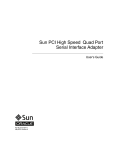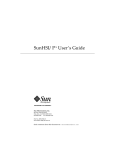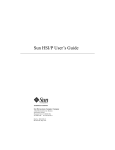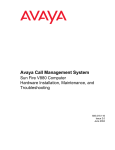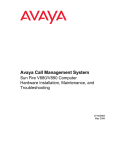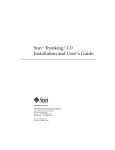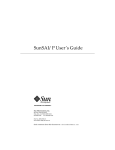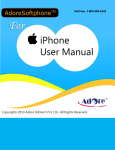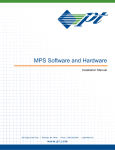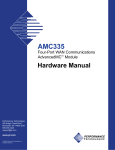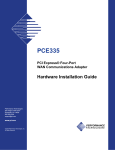Download Sun Microsystems Interface Adapter Network Card User Manual
Transcript
Sun™ PCI High Speed Quad Port Serial Interface Adapter User’s Guide Sun Microsystems, Inc. www.sun.com Part No. 819-1207-10 December 2005, Revision A Submit comments about this document at: http://www.sun.com/hwdocs/feedback Copyright 2005 Sun Microsystems, Inc., 4150 Network Circle, Santa Clara, California 95054, U.S.A. All rights reserved. Sun Microsystems, Inc. has intellectual property rights relating to technology that is described in this document. In particular, and without limitation, these intellectual property rights may include one or more of the U.S. patents listed at http://www.sun.com/patents and one or more additional patents or pending patent applications in the U.S. and in other countries. This document and the product to which it pertains are distributed under licenses restricting their use, copying, distribution, and decompilation. No part of the product or of this document may be reproduced in any form by any means without prior written authorization of Sun and its licensors, if any. Third-party software, including font technology, is copyrighted and licensed from Sun suppliers. Parts of the product may be derived from Berkeley BSD systems, licensed from the University of California. UNIX is a registered trademark in the U.S. and in other countries, exclusively licensed through X/Open Company, Ltd. Sun, Sun Microsystems, the Sun logo, Java, AnswerBook2, docs.sun.com, SunHSI, SunHSI/P, SunHSI/U, SunSolve, SunVTS, Solstice, SunLink, SunFire, and Solaris are trademarks or registered trademarks of Sun Microsystems, Inc. in the U.S. and in other countries. All SPARC trademarks are used under license and are trademarks or registered trademarks of SPARC International, Inc. in the U.S. and in other countries. Products bearing SPARC trademarks are based upon an architecture developed by Sun Microsystems, Inc. The OPEN LOOK and Sun™ Graphical User Interface was developed by Sun Microsystems, Inc. for its users and licensees. Sun acknowledges the pioneering efforts of Xerox in researching and developing the concept of visual or graphical user interfaces for the computer industry. Sun holds a non-exclusive license from Xerox to the Xerox Graphical User Interface, which license also covers Sun’s licensees who implement OPEN LOOK GUIs and otherwise comply with Sun’s written license agreements. U.S. Government Rights—Commercial use. Government users are subject to the Sun Microsystems, Inc. standard license agreement and applicable provisions of the FAR and its supplements. DOCUMENTATION IS PROVIDED "AS IS" AND ALL EXPRESS OR IMPLIED CONDITIONS, REPRESENTATIONS AND WARRANTIES, INCLUDING ANY IMPLIED WARRANTY OF MERCHANTABILITY, FITNESS FOR A PARTICULAR PURPOSE OR NON-INFRINGEMENT, ARE DISCLAIMED, EXCEPT TO THE EXTENT THAT SUCH DISCLAIMERS ARE HELD TO BE LEGALLY INVALID. Copyright 2005 Sun Microsystems, Inc., 4150 Network Circle, Santa Clara, Californie 95054, Etats-Unis. Tous droits réservés. Sun Microsystems, Inc. a les droits de propriété intellectuels relatants à la technologie qui est décrit dans ce document. En particulier, et sans la limitation, ces droits de propriété intellectuels peuvent inclure un ou plus des brevets américains énumérés à http://www.sun.com/patents et un ou les brevets plus supplémentaires ou les applications de brevet en attente dans les Etats-Unis et dans les autres pays. Ce produit ou document est protégé par un copyright et distribué avec des licences qui en restreignent l’utilisation, la copie, la distribution, et la décompilation. Aucune partie de ce produit ou document ne peut être reproduite sous aucune forme, par quelque moyen que ce soit, sans l’autorisation préalable et écrite de Sun et de ses bailleurs de licence, s’il y en a. Le logiciel détenu par des tiers, et qui comprend la technologie relative aux polices de caractères, est protégé par un copyright et licencié par des fournisseurs de Sun. Des parties de ce produit pourront être dérivées des systèmes Berkeley BSD licenciés par l’Université de Californie. UNIX est une marque déposée aux Etats-Unis et dans d’autres pays et licenciée exclusivement par X/Open Company, Ltd. Sun, Sun Microsystems, le logo Sun, Java, AnswerBook2, docs.sun.com, SunHSI, SunHSI/P, SunHSI/U, SunSolve, SunVTS, Solstice, SunLink, SunFire, et Solaris sont des marques de fabrique ou des marques déposées de Sun Microsystems, Inc. aux Etats-Unis et dans d’autres pays. Toutes les marques SPARC sont utilisées sous licence et sont des marques de fabrique ou des marques déposées de SPARC International, Inc. aux Etats-Unis et dans d’autres pays. Les produits portant les marques SPARC sont basés sur une architecture développée par Sun Microsystems, Inc. L’interface d’utilisation graphique OPEN LOOK et Sun™ a été développée par Sun Microsystems, Inc. pour ses utilisateurs et licenciés. Sun reconnaît les efforts de pionniers de Xerox pour la recherche et le développement du concept des interfaces d’utilisation visuelle ou graphique pour l’industrie de l’informatique. Sun détient une license non exclusive de Xerox sur l’interface d’utilisation graphique Xerox, cette licence couvrant également les licenciées de Sun qui mettent en place l’interface d ’utilisation graphique OPEN LOOK et qui en outre se conforment aux licences écrites de Sun. LA DOCUMENTATION EST FOURNIE "EN L’ÉTAT" ET TOUTES AUTRES CONDITIONS, DECLARATIONS ET GARANTIES EXPRESSES OU TACITES SONT FORMELLEMENT EXCLUES, DANS LA MESURE AUTORISEE PAR LA LOI APPLICABLE, Y COMPRIS NOTAMMENT TOUTE GARANTIE IMPLICITE RELATIVE A LA QUALITE MARCHANDE, A L’APTITUDE A UNE UTILISATION PARTICULIERE OU A L’ABSENCE DE CONTREFAÇON. Please Recycle Contents Regulatory Compliance Statements Declaration of Conformity Preface 1. xi xv xvii Product Overview 1 Product Description Features 1 2 Hardware and Software Requirements 2. SunHSI/U Adapter Installation Installation Process ▼ 5 5 To Install the Adapter External Cabling 5 6 RS-232 to RS-449 Connections 3. 3 SunHSI PCI Software Installation Installation Overview 7 9 9 Before Installing the Software 11 Verifying the Software and Hardware Requirements ▼ To Remove Older Versions of the Software 11 11 iii Installing the Software 12 ▼ To Install the SunHSI Software ▼ To Test the Installation Configuring the Software ▼ 4. SunHSI Utilities 14 17 T1 Compatibility Options 18 Operating Modes Options 18 19 IBM (SDLC) Mode hsip_loop Utility 20 hsip_stat Utility 21 19 Cable Pin Assignments & Signals Pin Assignments 23 Interface Signals 27 Null Modem Cable Requirements 23 29 Configuring Internal or External Clocking Building the Null Modem Cable RS-449 Null Modem Cable X.21 to RS-449 Converter C. 31 34 35 35 Bipolar with 8-Zero Substitution 36 HDLC Zero Insertion Algorithm 36 Clock Signal Inversion 30 30 T1 Inverted Data and Clock Signals Data Signal Inversion iv 15 17 HDLC Mode B. 14 To Configure for Point-to-Point Protocol hsip_init Utility A. 12 37 Sun PCI High Speed Quad Port Serial Interface Adapter User’s Guide • December 2005 D. SunVTS Diagnostic Testing 39 Using the SunVTS sunlink Test E. Viewing the Man Pages Man Pages 39 41 41 ▼ To View Man Pages in the C Shell Environment ▼ To View Man Pages in Bourne or Korn Shell Environments Glossary Index 41 42 43 45 Contents v vi Sun PCI High Speed Quad Port Serial Interface Adapter User’s Guide • December 2005 Figures FIGURE 1-1 SunHSI/U Adapter 2 FIGURE 3-1 SunHSI PCI Software Directories and Files FIGURE 3-2 SunHSI Devices Created by the Postinstallation Script FIGURE B-1 Null Modem Cable –Both Sun Systems Supplies Clocking FIGURE B-2 Null Modem Cable –Sun System Supplies Clocking for Both Sides FIGURE B-3 X.21 to RS-449 Converter 10 10 32 33 34 vii viii Sun PCI High Speed Quad Port Serial Interface Adapter User’s Guide • December 2005 Tables TABLE 1-1 Hardware and Software Requirements TABLE 3-1 Required Disk Space TABLE A-1 RS-449 Connector Pin Assignments TABLE A-2 RS-449 Interface Signals TABLE B-1 RS-449 Signals 31 TABLE B-2 X.21 Signals TABLE D-1 Sun VTS Documentation 3 11 23 27 31 39 ix x Sun PCI High Speed Quad Port Serial Interface Adapter User’s Guide • December 2005 Regulatory Compliance Statements Your Sun product is marked to indicate its compliance class: • • • • Federal Communications Commission (FCC) — USA Industry Canada Equipment Standard for Digital Equipment (ICES-003) — Canada Voluntary Control Council for Interference (VCCI) — Japan Bureau of Standards Metrology and Inspection (BSMI) — Taiwan Please read the appropriate section that corresponds to the marking on your Sun product before attempting to install the product. FCC Class A Notice This device complies with Part 15 of the FCC Rules. Operation is subject to the following two conditions: 1. This device may not cause harmful interference. 2. This device must accept any interference received, including interference that may cause undesired operation. Note: This equipment has been tested and found to comply with the limits for a Class A digital device, pursuant to Part 15 of the FCC Rules. These limits are designed to provide reasonable protection against harmful interference when the equipment is operated in a commercial environment. This equipment generates, uses, and can radiate radio frequency energy, and if it is not installed and used in accordance with the instruction manual, it may cause harmful interference to radio communications. Operation of this equipment in a residential area is likely to cause harmful interference, in which case the user will be required to correct the interference at his own expense. Modifications: Any modifications made to this device that are not approved by Sun Microsystems, Inc. may void the authority granted to the user by the FCC to operate this equipment. FCC Class B Notice This device complies with Part 15 of the FCC Rules. Operation is subject to the following two conditions: 1. This device may not cause harmful interference. 2. This device must accept any interference received, including interference that may cause undesired operation. Note: This equipment has been tested and found to comply with the limits for a Class B digital device, pursuant to Part 15 of the FCC Rules. These limits are designed to provide reasonable protection against harmful interference in a residential installation. This equipment generates, uses and can radiate radio frequency energy and, if not installed and used in accordance with the instructions, may cause harmful interference to radio communications. However, there is no guarantee that interference will not occur in a particular installation. If this equipment does cause harmful interference to radio or television reception, which can be determined by turning the equipment off and on, the user is encouraged to try to correct the interference by one or more of the following measures: • • • • Reorient or relocate the receiving antenna. Increase the separation between the equipment and receiver. Connect the equipment into an outlet on a circuit different from that to which the receiver is connected. Consult the dealer or an experienced radio/television technician for help. Modifications: Any modifications made to this device that are not approved by Sun Microsystems, Inc. may void the authority granted to the user by the FCC to operate this equipment. ICES-003 Class A Notice - Avis NMB-003, Classe A This Class A digital apparatus complies with Canadian ICES-003. Cet appareil numérique de la classe A est conforme à la norme NMB-003 du Canada. xi ICES-003 Class B Notice - Avis NMB-003, Classe B This Class B digital apparatus complies with Canadian ICES-003. Cet appareil numérique de la classe B est conforme à la norme NMB-003 du Canada. BSMI Class A Notice The following statement is applicable to products shipped to Taiwan and marked as Class A on the product compliance label. xii Sun PCI High Speed Quad Port Serial Interface Adapter User’s Guide • December 2005 CCC Class A Notice The following statement is applicable to products shipped to China and marked with “Class A” on the product’s compliance label. GOST-R Certification Mark Regulatory Compliance Statements xiii xiv Sun PCI High Speed Quad Port Serial Interface Adapter User’s Guide • December 2005 Declaration of Conformity Compliance Model Number: Product Family Name: HSI-U Sun PCI High Speed Serial Interface Adapter (X1355a) EMC USA—FCC Class A This equipment complies with Part 15 of the FCC Rules. Operation is subject to the following two conditions: 1. This equipment may not cause harmful interference. 2. This equipment must accept any interference that may cause undesired operation. European Union This equipment complies with the following requirements of the EMC Directive 89/336/EEC: As Telecommunication Network Equipment (TNE) in Both Telecom Centers and Other Than Telecom Centers per (as applicable): EN 300 386 V.1.3.2 (2003-05) Required Limits: EN 55022:1994 +A1:1995 +A2:1997 ClassA EN 61000-3-2:2000 Pass EN 61000-3-3:1995 +A1:2000 Pass IEC 61000-4-2 6 kV (Direct), 8 kV (Air) IEC 61000-4-3 3 V/m 80-1000MHz, 10 V/m 800-960 MHz, and 1400-2000 MHz IEC 61000-4-4 1 kV AC and DC Power Lines, 0.5 kV Signal Lines IEC 61000-4-5 2 kV AC Line-Gnd, 1 kV AC Line-Line and Outdoor Signal Lines, 0.5 kV Indoor signal Lines > 10m. IEC 61000-4-6 3V IEC 61000-4-11 Pass As Information Technology Equipment (ITE) Class A per (as applicable): EN 55022:1994 +A1:1995 +A2:1997 Class A EN 61000-3-2:2000 Pass EN 61000-3-3:1995 +A1:2000 Pass EN 55024:1998 +A1:2001 +A2:2003 Required Limits: IEC 61000-4-2 4 kV (Direct), 8 kV (Air) IEC 61000-4-3 3 V/m IEC 61000-4-4 1 kV AC Power Lines, 0.5 kV Signal and DC Power Lines IEC 61000-4-5 1 kV AC Line-Line and Outdoor Signal Lines, 2 kV AC Line-Gnd, 0.5 kV DC Power Lines IEC 61000-4-6 3V IEC 61000-4-8 1 A/m IEC 61000-4-11 Pass Safety: This equipment complies with the following requirements of the Low Voltage Directive 73/23/EEC: EC Type Examination Certificates: EN 60950-1:2001, 1st Edition IEC 60950-1:2001, 1st Edition Evaluated to all CB Countries UL 60950-1:2003, 1st Edition, CSA C22.2 No. 60950-1-03 Chomerics Report No. SAFR0126B.03 CB Scheme Certificate No. File: Supplementary Information: This product was tested and complies with all the requirements for the CE Mark. This equipment complies with the Restriction of Hazardous Substances (RoHS) directive 2002/95/EC. /S/ Dennis P. Symanski Worldwide Compliance Office Sun Microsystems, Inc. 4150 Network Circle, MPK15-102 Santa Clara, CA 95054 U.S.A. Tel: 650-786-3255 Fax: 650-786-3723 DATE /S/ Donald Cameron DATE Program Manager/Customer Quality Sun Microsystems Scotland, Limited Blackness Road, Phase I, Main Bldg. Springfield, EH49 7LR Scotland, United Kingdom Tel: +44 1 506 672 539 Fax: +44 1 506 670 011 xv xvi Sun PCI High Speed Quad Port Serial Interface Adapter User’s Guide • December 2005 Preface This document provides information for users of the Sun™ PCI High Speed Quad Port Serial Interface adapter. Information provided includes adapter installation, software installation and configuration, utilities, cable pin-outs and signals, and null modem cable requirements. This document is intended for use by either first-time or experienced users. If you have just acquired this product, review the introductory sections and follow the guidelines for installing and using the adapter. Note – The Sun PCI High Speed Quad Port Serial Interface adapter is high-speed serial-interface (HSI) adapter for PCI applications The adapter is referred to as SunHSI/U™ in this manual. How This Book Is Organized This document is organized as follows: Chapter 1 describes the products and lists system requirements. Chapter 2 provides instructions for installing the adapter. Chapter 3 contains the SunHSI™ software installation instructions. Chapter 4 describes the utilities supplied with the SunHSI software. Appendix A lists the cable pin assignments and signals. Appendix B provides information on external clocking and the null modem cable. Appendix C explains the inverted data and clock signals for T1. xvii Appendix D gives an overview of the SunVTS™ diagnostic software. Appendix E provides instructions for viewing the man pages. Using UNIX Commands This document might not contain information about basic UNIX® commands and procedures such as shutting down the system, booting the system, and configuring devices. Refer to the following for this information: ■ Software documentation that you received with your system ■ Solaris™ Operating System documentation, which is at: http://docs.sun.com Shell Prompts xviii Shell Prompt C shell machine-name% C shell superuser machine-name# Bourne shell and Korn shell $ Bourne shell and Korn shell superuser # Sun PCI High Speed Quad Port Serial Interface Adapter User’s Guide • December 2005 Typographic Conventions Typeface1 Meaning Examples AaBbCc123 The names of commands, files, and directories; on-screen computer output Edit your.login file. Use ls -a to list all files. % You have mail. AaBbCc123 What you type, when contrasted with on-screen computer output % su Password: AaBbCc123 Book titles, new words or terms, words to be emphasized. Replace command-line variables with real names or values. Read Chapter 6 in the User’s Guide. These are called class options. You must be superuser to do this. To delete a file, type rm filename. 1 The settings on your browser might differ from these settings. Related Documentation The documents listed as online are available at: http://www.sun.com/documentation Application Title Part Number Format Location Installation Sun PCI High Speed Quad Port Serial Interface Adapter Release Notes 819-1208 PDF Online HTML Online PDF Online HTML Online Installation and User Information Sun PCI High Speed Quad Port Serial Interface Adapter User’s Guide 819-1207-10 Preface xix Documentation, Support, and Training Sun Function URL Documentation http://www.sun.com/documentation/ Support http://www.sun.com/support/ Training http://www.sun.com/training/ Third-Party Web Sites Sun is not responsible for the availability of third-party web sites mentioned in this document. Sun does not endorse and is not responsible or liable for any content, advertising, products, or other materials that are available on or through such sites or resources. Sun will not be responsible or liable for any actual or alleged damage or loss caused by or in connection with the use of or reliance on any such content, goods, or services that are available on or through such sites or resources. Sun Welcomes Your Comments Sun is interested in improving its documentation and welcomes your comments and suggestions. You can submit your comments by going to: http://www.sun.com/hwdocs/feedback Please include the title and part number of your document with your feedback: Sun PCI High Speed Quad Port Serial Interface Adapter User’s Guide, part number 819-1207-10 xx Sun PCI High Speed Quad Port Serial Interface Adapter User’s Guide • December 2005 CHAPTER 1 Product Overview This chapter includes the following topics: ■ ■ ■ “Product Description” on page 1 “Features” on page 2 “Hardware and Software Requirements” on page 3 Product Description The Sun PCI High Speed Quad Port Serial Interface adapter is high-speed serial interface (HSI) adapter for PCI applications and is referred to as the SunHSI/U™ adapter in this manual. The adapter offers comprehensive hot-plug compatibility with Solstice™ WAN software packages available through Sun. The SunHSI™ software is a transparent interface on the SunHSI/U adapter, providing a compliant environment for SunLink™ WAN packages operating on similar Sun communication modules. The SunHSI/U adapter (see FIGURE 1-1) is an intelligent, four-port communication controller with onboard CPU and memory dedicated to WAN communication functions. This architecture operates much more efficiently at high data rates than unintelligent WAN modules. Onboard intelligence allows the workstation or server to be off-loaded from many of the low-level communication tasks that it must perform when there is no native intelligence on the controller. 1 FIGURE 1-1 SunHSI/U Adapter The adapter comes with the RS-449 industry standard connectors (for example, DB-37). The protocols that operate with the SunHSI/U adapter include the Solstice X.25 and Solstice Point-to-Point Protocol (PPP). The SunHSI/U adapter conforms to the Sun Synchronous Serial Driver Interface Specification. Features ■ ■ ■ ■ ■ ■ ■ ■ 2 Four synchronous RS-449 serial ports Each port can be independently configured T1/E1 transfer speed simultaneously on all four ports Works in 3.3 Volt 66 MHz and 5 Volt 33 MHz PCI slots Increased RS-232 support for data transmission range, up to 100 Kbps Meets PCI local bus specification, rev. 2.2 Solaris 64-bit and 32-bit Operating System compatibility Hot-plug capability Sun PCI High Speed Quad Port Serial Interface Adapter User’s Guide • December 2005 Hardware and Software Requirements The hardware and software requirements for the SunHSI/U adapter are listed in TABLE 1-1. TABLE 1-1 Hardware and Software Requirements Sun Systems Workstations Sun Blade™ 100, 150, 1500, 1000, 2000, 2500 Servers Sun Fire™ V210, V240, 280R, V440, V480, V490, V880, V890, V1280, E2900, E6900/E4900, 15K/12K, E25K/E20K NEBS-certified servers Netra™ 240, 440, 1280 Operating Systems Solaris 10, Solaris 9, and Solaris 8 SunHSI Software (PCI device drivers, man pages, and utilities) SunHSI/P™ 3.1 or newer† Diagnostics Version Solaris 10 Solaris 9 Solaris 8 SunVTS™ 6.0 and subsequent compatible releases SunVTS 5.0 and subsequent compatible releases SunVTS 4.0 and subsequent compatible releases † The Sun HSI/P software is downloadable from the Sun Download Center at: http://www.sun.com/download Chapter 1 Product Overview 3 4 Sun PCI High Speed Quad Port Serial Interface Adapter User’s Guide • December 2005 CHAPTER 2 SunHSI/U Adapter Installation This chapter describes how to install the adapter in your system and includes the following topics: ■ ■ ■ “Installation Process” on page 5 “To Install the Adapter” on page 5 “External Cabling” on page 6 Installation Process A simplified version of the installation process follows: 1. Install the adapter (see “To Install the Adapter” on page 5). 2. Install the SunHSI PCI software (see “SunHSI PCI Software Installation” on page 9). 3. Test the installation (see “To Test the Installation” on page 14). ▼ To Install the Adapter Caution – Electronic components on printed circuit boards are extremely sensitive to static electricity. Ordinary amounts of static electricity generated by your clothing or work environment can damage the electronic equipment. When installing the SunHSI/U adapter in a system, use anti-static grounding straps and antistatic mats to help prevent damage due to electrostatic discharge. 5 Note – Refer to your system installation guide or service manual for detailed instructions for the following steps. 1. Power off your system, using the standard shutdown procedures described in the Solaris Handbook for Sun Peripherals or your system service manual. The Solaris Handbook for Sun Peripherals is shipped with the Solaris OS software and is available on the http://docs.sun.com web site. 2. Remove the cover from the unit to access the card slots and connectors. 3. Select an available 3.3 Volt or 5 Volt PCI slot and remove the slot filler panel. 4. Insert the adapter into the PCI connector of the system unit. Ensure that the front plate on the adapter mounts flush with the chassis panel opening. 5. Install the front plate screw to secure the adapter into the chassis. This also provides a chassis ground connection to the adapter. 6. Reinstall the cover on the unit. 7. Attach the serial port cable assembly to the I/O connector on the adapter. 8. Connect any cables from the peripheral devices to the RS-449 connectors on the adapter’s cable. 9. Turn power back on and allow the system to reboot. This completes the hardware installation. Proceed to “SunHSI PCI Software Installation” on page 9. External Cabling The SunHSI/U adapter provides external connectivity through a passive cabling system. A hydra-style connector provides connectivity to four RS-449 devices by means of four DB-37 female connectors in a DTE configuration. Note – Always use shielded twisted pair RS-449 cables with your SunHSI/U adapter. 6 Sun PCI High Speed Quad Port Serial Interface Adapter User’s Guide • December 2005 RS-232 to RS-449 Connections In order to connect RS-232 devices to the adapter, you need to install an externally powered RS-449 to RS-232 interface converter to each DB-37 connector on which you intend to connect an RS-232 device. A converter is necessary because of incompatibilities between RS-232 and RS-449 signal levels. To obtain an externally powered RS-232 to RS-449 interface converter, contact: Black Box Corporation at: http://www.blackbox.com Note – Use only externally powered RS-449 devices with the SunHSI/U adapter. Chapter 2 SunHSI/U Adapter Installation 7 8 Sun PCI High Speed Quad Port Serial Interface Adapter User’s Guide • December 2005 CHAPTER 3 SunHSI PCI Software Installation This chapter describes how to install the SunHSI PCI software and includes the following sections: ■ ■ ■ ■ “Installation Overview” on page 9 “Before Installing the Software” on page 11 “Installing the Software” on page 12 “Configuring the Software” on page 14 Installation Overview Software for unbundled products is distributed in the form of software packages. The SunHSI PCI software package can be downloaded from the Sun Download Center at: http://www.sun.com/download You can use the pkgadd command to install software packages, to spool software packages for installation at a later date, or to remove software packages from your system. For more information see the Solaris System Administration Guide. When you have completed the software installation and run the postinstallation script, you will have created the software directories and files illustrated in FIGURE 3-1 and FIGURE 3-2. Note – If you are upgrading to the SunHSI/U adapter from the SunHSI/P adapter or if you are running a SunHSI/P adapter along with the SunHSI/U adapter, you must upgrade the SunHSI software to the latest version. 9 /root /bin /opt /kernel /SUNWconn /drv /HSIP /man HSIP /man7d hsip_init* /man1m hsip_loop* hsip_stat* hsip_init.1m* hsip.7d* hsip_loop.1m* /man1m hspi_stat.1m* /bin /man HSIP /man7d hsip_init.1m hsip_loop.1m hsip_stat.1m /sparcv9 hsip.7d hsip_init hsip_loop hsip_stat * Symbolic link. FIGURE 3-1 SunHSI PCI Software Directories and Files /root /dev /hihp Clone device (Control Port) FIGURE 3-2 10 /hihp0 /hihp1 /hihp2 /hihp3 /hihp4 /hihp5 /hihp6 /hihp7 /hihp8 /hihp9 /hihp10 /hihp11 /hihpn /hihpn /hihpn /hihpn Board 1 Board 2 Board 3 Board N SunHSI Devices Created by the Postinstallation Script Sun PCI High Speed Quad Port Serial Interface Adapter User’s Guide • December 2005 Before Installing the Software Verifying the Software and Hardware Requirements Before installing the software, answer the following questions: ■ Does your system have any available 3.3V or 5V PCI slots? ■ Have you downloaded the SunHSI software from the Sun Download Center at: http://www.sun.com/download ■ What is the installation directory (default directory is /opt)? ■ Do you have the superuser password for both the system where the software is to be installed and the system with download software, if different? ■ Does your system have enough disk space? Use both the following commands to check for disk space: # df -k /opt # df -k / TABLE 3-1 ▼ Required Disk Space SunHSI Package Name Default Installation Directory Approximate Space Required SUNWhsip / 1 Mbyte SUNWhsipm and SUNWhsipu /opt 1 Mbyte total To Remove Older Versions of the Software Caution – Do not overwrite any existing SunHSI software packages. If you install the SunHSI software packages over existing SunHSI software packages, you will have two instances of the software packages. This might cause problems when installing or backing out of software patches. Chapter 3 SunHSI PCI Software Installation 11 Before installing the SunHSI PCI software on your system, check your system to see if previous versions of the SunHSI software are installed. If older SunHSI software exists, you must remove this software before installing the new SunHSI software. ● Using the pkginfo command, check the system for installed SunHSI software packages: # /usr/bin/pkginfo | grep SUNWhsip system SUNWhsip SunHSI/P Driver for PCI system SUNWhsipm SunHSI/P Man Pages for PC system SUNWhsipu SunHSI/P Utilities for PCI ■ If no SunHSI packages are installed, skip to the next section, “Installing the Software” on page 12, to continue with the software installation. ■ If there are SunHSI packages installed, remove them by logging on as superuser (root) and typing the following command: # /usr/sbin/pkgrm SUNWhsip SUNWhsipu SUNWhsipm Installing the Software The SunHSI PCI driver, utilities, and man pages are distributed in the standard Solaris pkgadd distribution format. The pkgadd utility loads the SUNWhsip, SUNWhsipm, and SUNWhsipu packages onto the system from the distribution media. ▼ To Install the SunHSI Software 1. Access the directory where the SunHSI software has been downloaded. # cd download-directory where download-directory is the name of the directory where the SunHSI software was downloaded. 12 Sun PCI High Speed Quad Port Serial Interface Adapter User’s Guide • December 2005 2. Log in as superuser or change to superuser. You must possess superuser privileges to invoke the following commands. This ensures that all preinstallation scripts in the software package will be executed with superuser privileges. # /usr/bin/su Password: superuser-password 3. Using the pkgadd command, install the software packages as follows:. # pkgadd -d / download-directory/sunhsip_3_1/Product The following packages are available: 1 SUNWhsip SunHSI/P Driver for PCI 3.1,REV=2005.xx.xx 2 SUNWhsipm SunHSI/P Man pages for PCI 3.1,REV=2005.xx.xx 3 SUNWhsipu SunHSI/P Utilities for PCI 3.1,REV=2005.xx.xx Select package(s) you wish to process (or ’all’ to process all packages). (default: all) [?,??,q]: all where download-directory is the name of the directory where the SunHSI software was downloaded. a. Type all or leave blank then press the Return key to continue the installation of the driver software. If the pkgadd utility warns you that some scripts must be executed with superuser permissions, type y. 4. After successful completion of the package installation, reboot the system using the reconfigure option. a. Synchronize the hard disks and halt the system, using the following commands. # /usr/sbin/sync # /usr/sbin/halt b. At the ok prompt, type the boot command with the -r option: ok boot -r Chapter 3 SunHSI PCI Software Installation 13 5. After the system reboots, verify the installation by typing the following commands: # /usr/bin/pkginfo | grep SUNWhsip system SUNWhsip SunHSI/P Driver for PCI system SUNWhsipm SunHSI/P Man Pages for PC system SUNWhsipu SunHSI/P Utilities for PCI # modinfo | grep HSIP 126 7bb24000 17708 150 1 HSIP (PT-PCI334 Driver) # grep HSIP /etc/path_to_inst "/ssm@0,0/pci@18,700000/pci1214,334a@2" 0 "HSIP" The output shows that the packages are installed, the driver is loaded, and that the software is mapped to the adapter. ▼ To Test the Installation ● Type the following command (replace n with the adapter port you are testing): # hsip_loop -c 100 -l 2048 -s 2048000 -t 1 hihpn This command runs an internal loopback test. For more information, see the hsip_loop(1M) man page. Configuring the Software To configure the adapter for the Point-to-Point Protocol (PPP), see “To Configure for Point-to-Point Protocol” on page 15. Also refer to the Solaris System Administration Guide: Network Services documentation for the version of Solaris that you are running. These documents are available from the following web site: http://docs.sun.com/ To configure the adapter for the X.25 9.2 protocol, refer to the Solstice X.25 9.2 Administration Guide (806-1234). The X.25 9.2 documents are available from the following web site: http://docs.sun.com/ 14 Sun PCI High Speed Quad Port Serial Interface Adapter User’s Guide • December 2005 ▼ To Configure for Point-to-Point Protocol 1. Change to the /etc/ppp directory and create an executable file called conf_hsip, containing the following information: #!/bin/ksh -x DEVICE=‘echo $DEVICE | sed ’s/⁄dev⁄//’‘ /opt/SUNWconn/bin/hsip_init $DEVICE speed=2048000 mode=fdx loopback=no \ nrzi=no txc=baud rxc=rxc txd=txd rxd=rxd signal=no 2>&1 > /dev/null 2. Create another executable file called demand, containing the following information: if [ -f /var/run/ppp-demand.pid ] && /usr/bin/kill -s 0 ‘/bin/cat /var/run/ppp-demand.pid‘ then : else env DEVICE=hihp0 /usr/bin/pppd hihp0 :qa1b-hihp0 call far-hsip env DEVICE=hihp1 /usr/bin/pppd hihp1 :qa1b-hihp1 call far-hsip env DEVICE=hihp2 /usr/bin/pppd hihp2 :qa1b-hihp2 call far-hsip env DEVICE=hihp3 /usr/bin/pppd hihp3 :qa1b-hihp3 call far-hsip fi 3. Change to the /etc/ppp/peers directory and create an executable file called far-hsip, containing the following information: connect ’/etc/ppp/conf-hsip’ local sync noauth 0: ipcp-accept-local nodefaultroute passive persist noccp nopcomp novj noaccomp Chapter 3 SunHSI PCI Software Installation 15 4. Add the client site hosts on the server machine and add the server site hosts on the client machine. a. Edit the server’s /etc/hosts file and add the client site local hosts. b. Edit the client’s /etc/hosts file and add the server site local hosts. Note – Both IP addresses have to be on the same subnet. Refer to the hosts(4) man page and the sample /etc/hosts files: #Server site (/etc/hosts) #======================= #local 192.10.10.10 qa8a-hihp0 193.10.10.10 qa8a-hihp1 194.10.10.10 qa8a-hihp2 195.10.10.10 qa8a-hihp3 # Client site (/etc/hosts) # ======================= #local 192.10.10.20 qa1b-hihp0 193.10.10.20 qa1b-hihp1 194.10.10.20 qa1b-hihp2 195.10.10.20 qa1b-hihp3 #remote 192.10.10.20 193.10.10.20 194.10.10.20 195.10.10.20 # remote 192.10.10.10 193.10.10.10 194.10.10.10 195.10.10.10 qa1b-hihp0 qa1b-hihp1 qa1b-hihp2 qa1b-hihp3 qa8a-hihp0 qa8a-hihp1 qa8a-hihp2 qa8a-hihp 5. Edit the /etc/netmasks file as follows: 192.10.10.0 193.10.10.0 194.10.10.0 195.10.10.0 255.255.255.0 255.255.255.0 255.255.255.0 255.255.255.0 6. Start the PPP connection by typing the following commands: /etc/rc2.d/S47pppd stop /etc/rc2.d/S47pppd start boot -r 16 Sun PCI High Speed Quad Port Serial Interface Adapter User’s Guide • December 2005 CHAPTER 4 SunHSI Utilities The SunHSI software includes the hsip_init, hsip_loop, and hsip_stat utilities. This chapter contains a short description of each utility. Refer to each man page to get more information on the commands. Also see “Viewing the Man Pages” on page 41. This chapter includes the following topics: ■ ■ ■ “hsip_init Utility” on page 17 “hsip_loop Utility” on page 20 “hsip_stat Utility” on page 21 Note – You need to be superuser (root) in order to run the hsip_init, hsip_loop, or hsip_stat utilities. hsip_init Utility The hsip_init utility enables you to modify some of the hardware operating modes common to synchronous serial lines. This modification is needed for the operation of some communications packages and is useful in troubleshooting a link. See the hsip_init(1M) man page for details. The hsip_init utility includes options for T1 compatibility and operating modes. See “T1 Compatibility Options” on page 18 and “Operating Modes Options” on page 18 for information on these options. 17 T1 Compatibility Options The version of the hsip_init utility shipped with the SunHSI software has options that enable you to invert data and clock signals to accommodate the requirements of T1 or CEPT transmission equipment. The hsip_init parameters that allow for inversion are: ■ ■ ■ ■ txd rxd txc rxc – – – – transmit data signal receive data signal transmit clock signal receive clock signal The effect of the default settings for all of these parameters is that SunHSI software does not invert the data or clock signal controlled by the parameter. To invert a signal, you specify a setting of the form param-name=-paramname, for example, txc=-txc. As an example, suppose you want to invert the transmit and receive data signals on the first SunHSI/U port (port 0) on the second SunHSI/U adapter in your system. To do so, enter the following command: # hsip_init hihp4 txd=-txd rxd=-rxd To invert both clock and data signals, enter: # hsip_init hihp4 txd=-txd rxd=-rxd txc=-txc rxc=-rxc Appendix C discusses the background and requirements for these inverted settings. Operating Modes Options This section describes the operating modes that you can set with the hsip_init utility. The SunHSI software operates in two main operating modes, the high-level data link control (HDLC) mode and the IBM (SDLC) mode. The HDLC mode always operates in a full-duplex, point-to-point fashion. While the IBM mode defaults to a full-duplex, point-to-point, operation, you can also set this mode to be either a half-duplex or a multipoint operation. 18 Sun PCI High Speed Quad Port Serial Interface Adapter User’s Guide • December 2005 HDLC Mode The default operating mode used by the SunHSI software is the HDLC full-duplex protocol (mode=fdx). In this mode the transmitter is always enabled. The transmitter sends flag bytes continuously when it is not sending a data frame. If no message is currently being transmitted, the driver will attempt to start sending its next message. At this point the driver indicates that it is busy transmitting, to prevent the transmission of another message concurrently. The driver also activates a mechanism that ensures that the transmit operation will not hang if the hardware is not responding. When the transmission is completed, the busy mechanism previously set is cleared and the next message can be transmitted. If the transmission is hung an abort sequence is sent instead of the cyclic redundancy check (CRC), so that the receiver will not interpret the frame as valid data. The message is discarded, and the output error statistic is incremented, which allows for a proper recovery by higher level protocols. The received data is buffered until a complete frame has been received. If any error occurs during the reception of a frame, the appropriate statistic is incremented and the frame is discarded. IBM (SDLC) Mode SDLC mode is designed to support IBM system network architecture (SNA) communications. It uses most of the same protocols used in HDLC mode, with two major exceptions: ■ When the line is idle, instead of sending flag bytes the transmitter is disabled. ■ The request-to-send (RTS) and clear-to-send (CTS) signals are used to gate transmission. IBM Full-Duplex Mode When the SunHSI software is set to this mode (mode=ibm-fdx), the software uses a full-duplex point-to-point communication protocol. Both ends of the link are expected to have RTS and CTS signals asserted at all times when data is being exchanged. When starting a message transmission, the interface raises the RTS signal and expects the CTS signal to be asserted immediately. If this is not done, all messages currently queued for transmission are discarded, and the write operation returns an error. Chapter 4 SunHSI Utilities 19 If the CTS signal drops before the frame transmission is complete, the frame is discarded and the abort error statistic is incremented. If the transmission underruns, an abort sequence is not sent and the frame is silently discarded. The RTS signal remains asserted until the data transmission is complete. IBM Half-Duplex Mode Half-duplex is a submode of the IBM mode (mode=ibm-hdx). Half-duplex mode operates in the same manner as full-duplex mode except that transmission cannot occur while receiving, and vice-versa. When a transmission is completed, the RTS signal is dropped. Dropping the RTS signal tells the remote station to begin transmitting if it is ready to. IBM MultiPoint Mode In a multipoint configuration (mode=ibm-mpt), more than two stations share a link. This configuration is accomplished by designating one station as a primary station and the rest as secondary stations. In this mode, the port acts as a secondary station. The primary station arbitrates traffic on the link by polling the secondary stations, to see if they are ready to transmit. If a secondary station has data to transmit, it will raise its RTS signal and check for CTS signals. When a CTS signal comes up the station may begin transmitting, following the same rules for RTS and CTS signals used in half-duplex mode. When the transmission is complete the secondary drops the RTS signal, which enables another station to respond to a poll and begin transmitting. The RTS signal cannot be dropped until the transmission is complete. hsip_loop Utility The hsip_loop utility is high-speed, synchronous, serial loopback test program for high-speed serial interface. The utility performs several loopback tests that exercise the components of a serial communications link. See the hsip_loop(1M) man page for more information. 20 Sun PCI High Speed Quad Port Serial Interface Adapter User’s Guide • December 2005 hsip_stat Utility The hsip_stat utility reports the event statistics maintained by the SunHSI device driver. The report might be a single snapshot of the accumulated totals, or a series of samples showing incremental changes. At the beginning of the report, the device name being used to query a particular device appears. See the hsip_stat(1M) man page for more information. Chapter 4 SunHSI Utilities 21 22 Sun PCI High Speed Quad Port Serial Interface Adapter User’s Guide • December 2005 APPENDIX A Cable Pin Assignments & Signals This appendix includes the following information: ■ ■ “Pin Assignments” on page 23 “Interface Signals” on page 27 Pin Assignments A shielded, hydra-style breakout cable providing four 37-pin, D-shell (DB-37) DTE connectors is available for the SunHSI/U adapter. Since there are not enough wires to create the signal ground (pin 19) connections, use the shield ground (pin 1) of the DB-37 connector for this signal. The pin assignments for the cabling and connectors are shown in TABLE A-1. TABLE A-1 RS-449 Connector Pin Assignments 80-Pin Amp. Pin No. RS-449 Signal Name RS-449 DB-37 Pin No. Description 1 RxD1(A) 6 Port 1 Receive Data 2 RxD1(B) 24 Port 1 Receive Data 3 DTR1(A) 12 Port 1 Data Terminal Ready 4 DTR1(B) 30 Port 1 Data Terminal Ready 5 TxD1(A) 4 Port 1 Transmit Data 6 TxD1(B) 22 Port 1 Transmit Data 7 RTS1(A) 7 Port 1 Request To Send 8 RTS1(B) 25 Port 1 Request To Send 9 TxC1(A) 17 Port 1 Transmit Clock 23 TABLE A-1 24 RS-449 Connector Pin Assignments (Continued) 80-Pin Amp. Pin No. RS-449 Signal Name RS-449 DB-37 Pin No. Description 10 TxC1(B) 35 Port 1 Transmit Clock 11 TxCI1(A) 5 Port 1 Transmit Clock In 12 TxCI1(B) 23 Port 1 Transmit Clock In 13 DCD1(A) 13 Port 1 Data Carrier Detect 14 DCD1(B) 31 Port 1 Data Carrier Detect 15 DSR1(A) 11 Port 1 Data Set Ready 16 DSR1(B) 29 Port 1 Data Set Ready 17 CTS1(A) 9 Port 1 Clear To Send 18 CTS1(B) 27 Port 1 Clear To Send 19 RxC1(A) 8 Port 1 Receive Clock 20 RxC1(B) 26 Port 1 Receive Clock Shield Ground SG 1 Port 1 Shield Ground and Signal Ground 21 RxD2(A) 6 Port 2 Receive Data 22 RxD2(B) 24 Port 2 Receive Data 23 DTR2(A) 12 Port 2 Data Terminal Ready 24 DTR2(B) 30 Port 2 Data Terminal Ready 25 TxD2(A) 4 Port 2 Transmit Data 26 TxD2(B) 22 Port 2 Transmit Data 27 RTS2(A) 7 Port 2 Request To Send 28 RTS2(B) 25 Port 2 Request To Send 29 TxC2(A) 17 Port 2 Transmit Clock 30 TxC2(B) 35 Port 2 Transmit Clock 31 TxCI2(A) 5 Port 2 Transmit Clock In 32 TxCI2(B) 23 Port 2 Transmit Clock In 33 DCD2(A) 13 Port 2 Data Carrier Detect 34 DCD2(B) 31 Port 2 Data Carrier Detect 35 DSR2(A) 11 Port 2 Data Set Ready 36 DSR2(B) 29 Port 2 Data Set Ready 37 CTS2(A) 9 Port 2 Clear To Send Sun PCI High Speed Quad Port Serial Interface Adapter User’s Guide • December 2005 TABLE A-1 RS-449 Connector Pin Assignments (Continued) 80-Pin Amp. Pin No. RS-449 Signal Name RS-449 DB-37 Pin No. Description 38 CTS2(B) 27 Port 2 Clear To Send 39 RxC2(A) 8 Port 2 Receive Clock 40 RxC2(B) 26 Port 2 Receive Clock Shield Ground SG 1 Port 2 Shield Ground and Signal ground 41 RxD3(A) 6 Port 3 Receive Data 42 RxD3(B) 24 Port 3 Receive Data 43 DTR3(A) 12 Port 3 Data Terminal Ready 44 DTR3(B) 30 Port 3 Data Terminal Ready 45 TxD3(A) 4 Port 3 Transmit Data 46 TxD3(B) 22 Port 3 Transmit Data 47 RTS3(A) 7 Port 3 Request To Send 48 RTS3(B) 25 Port 3 Request To Send 49 TxC3(A) 17 Port 3 Transmit Clock 50 TxC3(B) 35 Port 3 Transmit Clock 51 TxCI3(A) 5 Port 3 Transmit Clock In 52 TxCI3(B) 23 Port 3 Transmit Clock In 53 DCD3(A) 13 Port 3 Data Carrier Detect 54 DCD3(B) 31 Port 3 Data Carrier Detect 55 DSR3(A) 11 Port 3 Data Set Ready 56 DSR3(B) 29 Port 3 Data Set Ready 57 CTS3(A) 9 Port 3 Clear To Send 58 CTS3(B) 27 Port 3 Clear To Send 59 RxC3(A) 8 Port 3 Receive Clock 60 RxC3(B) 26 Port 3 Receive Clock Shield Ground SG 1 Port 3 Shield Ground and Signal Ground 61 RxD4(A) 6 Port 4 Receive Data 62 RxD4(B) 24 Port 4 Receive Data 63 DTR4(A) 12 Port 4 Data Terminal Ready 64 DTR4(B) 30 Port 4 Data Terminal Ready Appendix A Cable Pin Assignments & Signals 25 TABLE A-1 26 RS-449 Connector Pin Assignments (Continued) 80-Pin Amp. Pin No. RS-449 Signal Name RS-449 DB-37 Pin No. Description 65 TxD4(A) 4 Port 4 Transmit Data 66 TxD4(B) 22 Port 4 Transmit Data 67 RTS4(A) 7 Port 4 Request To Send 68 RTS4(B) 25 Port 4 Request To Send 69 TxC4(A) 17 Port 4 Transmit Clock 70 TxC4(B) 35 Port 4 Transmit Clock 71 TxCI4(A) 5 Port 4 Transmit Clock In 72 TxCI4(B) 23 Port 4 Transmit Clock In 73 DCD4(A) 13 Port 4 Data Carrier Detect 74 DCD4(B) 31 Port 4 Data Carrier Detect 75 DSR4(A) 11 Port 4 Data Set Ready 76 DSR4(B) 29 Port 4 Data Set Ready 77 CTS4(A) 9 Port 4 Clear To Send 78 CTS4(B) 27 Port 4 Clear To Send 79 RxC4(A) 8 Port 4 Receive Clock 80 RxC4(B) 26 Port 4 Receive Clock Shield Ground SG 1 Port 4 Shield Ground and Signal ground Sun PCI High Speed Quad Port Serial Interface Adapter User’s Guide • December 2005 Interface Signals Functional descriptions of the RS-449 interface signals are provided in TABLE A-2. TABLE A-2 RS-449 Interface Signals RS-449 Pin Number Signal Name Function 1 Shield Ground Enables tandem sections of shielded cable to retain continuity through the connector. 19 Signal Ground (SG) Directly connects the DTE circuit ground to the DCE circuit ground, providing a path for DTE and DCE signal commons. 4/22 Transmit Data (TxD) Used by the DTE to pass binary data to the DCE for transmission over the communications channel. 6/24 Receive Data (RxD) Used by the DCE to pass binary data received from the communications channel to the DTE. 5/23 Transmit Clock in (TxCI) Enables the DCE to transmit signal element timing to the DTE. This enables the DTE Transmit Data signal on circuit TxD to be in synchronization with On/Off transitions on this lead. 8/26 Receive Clock (RxC) Transitions on this lead enables the DTE to time data received over circuit RxD. 17/35 Transmit Clock (TxC) Enables the DTE to provide transmit timing information to the DCE so that the DTE can synchronize with data arriving over the TxD lead. 7/25 Request to Send (RTS) Used by the DTE to advise the DCE it is ready to transmit data. 9/27 Clear to Send (CTS) Used by the DCE to advise the DTE that the DCE is ready to send data over the communications channel. 11/29 Data Set Ready (DSR) Used to advise the DTE of the Ready status on the DCE. In most cases, this signal simply implies the unit is powered on. 12/30 Data Terminal Ready (DTR) Used by the DTE to advise the DCE it is ready to transmit or receive. 13/31 Data Carrier Detect (DCD) The DCE uses this lead to advise the DTE that an incoming signal on the communications channel is present. When first initialized this signal is an indication to the DTE to expect data momentarily. Appendix A Cable Pin Assignments & Signals 27 28 Sun PCI High Speed Quad Port Serial Interface Adapter User’s Guide • December 2005 APPENDIX B Null Modem Cable Requirements A synchronous null modem cable is a specially configured cable that simulates modems that are connected back-to-back. When the distance between the two host systems is not great, you may be able to use a null modem cable instead of a synchronous modem or a synchronous modem eliminator. The maximum distance a null modem cable can work is determined by the specification for your serial port interface. There are two steps you must perform to use a null modem cable for machine supplied clocking: ■ Run hsip_init (see “Configuring Internal or External Clocking” on page 30) so that the Sun system, in the absence of a synchronous modem, supplies clocking on the serial line. ■ Build or configure the cable for the null modem. Note – You must run hsip_init each time you reboot your system. The following topics are included in this appendix: ■ ■ “Configuring Internal or External Clocking” on page 30 “Building the Null Modem Cable” on page 30 29 Configuring Internal or External Clocking To configure an RS-449 port to provide transmit clocking for itself as well as receive clocking for the other end of the link, set the txc (transmit clock) and rxc (receive clock) parameters in hsip_init to baud and rxc, respectively. For example, the following hsip_init command sets the data rate of the first SunHSI/U serial port to 9600 bps and sets the clocking as described: # hsip_init hihp0 9600 txc=baud rxc=rxc You enter such a command at both ends of a link if both sides are supplying clocking. If a Sun system is at each end of a link and one system supplies clocking for both sides, enter the following command on the system that is not supplying the clocking: # hsip_init hihp0 9600 txc=txc rxc=rxc Building the Null Modem Cable To build a null modem cable, you can configure your own cable or use a standard cable with an adapter box. Note – Be sure to use shielded, twisted-pair wire when building a null modem cable. If you decide to use an adapter box, be sure to obtain an adapter that allows you to change the pin configurations. Preconfigured adapters generally do not work with synchronous protocols because they do not handle clock signals correctly. 30 Sun PCI High Speed Quad Port Serial Interface Adapter User’s Guide • December 2005 RS-449 Null Modem Cable TABLE B-1 and TABLE B-2 list the signals and names for RS-499 and X.21 circuits. TABLE B-1 RS-449 Signals Circuit Name Direction TxD Transmit Data To DCE RxD Receive Data From DCE TxC Transmit Clock To DCE TxCI Transmit Clock In From DCE RxC Receive Clock From DCE RTS Request to Send To DCE CTS Clear to Send From DCE DCD Data Carrier Detect From DCE DTR Data Terminal Ready To DCE DSR Data Set Ready From DCE SG Signal Ground TABLE B-2 X.21 Signals Circuit Name Direction G Signal Ground T Transmit To DCE R Receive From DCE C Control To DCE I Indication From DCE S Signal Element Timing From DCE B Byte Timing From DCE Appendix B Null Modem Cable Requirements 31 FIGURE B-1 illustrates a synchronous null modem cable that enables you to connect two Sun systems that each supply clocking, using the RS-449 interface. Each Sun system supplies clocking on pins 17 and 35. The null modem cable routes this clocking to pins 8 and 26 on the opposite side to provide receive clocking. Because the RS-449 interface is balanced, there are two pins for each signal. For example, Transmit Data (TxD), pins 4 and 22, is connected to Received Data (RxD), pins 6 and 24. This means that pin 4 is connected to pin 6 and pin 22 is connected to pin 24. TxD (4,22) TxD (4,22) RxD (6,24) RxD (6,24) RTS (7,25) RTS (7,25) CTS (9,27) CTS (9,27) DSR (11,29) DSR (11,29) SG (19) SG (19) DCD (13,31) DCD (13,31) RxC (8,26) RxC (8,26) DTR (12,30) DTR (12,30) TxC (17,35) TxC (17,35) Sun workstation Sun workstation FIGURE B-1 32 Null Modem Cable –Both Sun Systems Supplies Clocking Sun PCI High Speed Quad Port Serial Interface Adapter User’s Guide • December 2005 FIGURE B-2 illustrates a synchronous null modem cable that enables you to connect to to another system, Sun or nonSun, using the RS-449 interface. The Sun system supplies both the transmit and receive clocks for the other system. Note that this null modem cable is not symmetrical. TxD (4,22) TxD (4,22) RxD (6,24) RxD (6,24) RTS (7,25) RTS (7,25) CTS (9,27) CTS (9,27) DSR (11,29) DSR (11,29) SG (19) SG (19) DCD (13,31) DCD (13,31) RxC (8,26) TxCI (5,23) DTR (12,30) RxC (8,26) TxC (17,35) DTR (12,30) Sun workstation that supplies clocking Sun System or other device FIGURE B-2 Null Modem Cable –Sun System Supplies Clocking for Both Sides Appendix B Null Modem Cable Requirements 33 X.21 to RS-449 Converter FIGURE B-3 illustrates the pin connections required for an X.21 to RS-449 converter. T(2,9) TxD (4,22) S (6,13) RxC (8,26) TxCI (5,23) C (3,10) RTS (7,25) CTS (9,27) R (4,11) RxD (6,24) I (5,12) DCD (13,31) G (8) SG (19) X.21 interface (15-pin connector) RS-449 interface workstation (37-pin connector) FIGURE B-3 X.21 to RS-449 Converter When using an X.21 conversion you must perform the following hsip_init operation: # hsip_init hihp0 9600 txc=txc rxc=rxc Note – Both receive and transmit clock inputs (RxC and TxCI) need a clock signal if txc is set to txc and rxc is set to rxc. 34 Sun PCI High Speed Quad Port Serial Interface Adapter User’s Guide • December 2005 APPENDIX C T1 Inverted Data and Clock Signals This appendix includes the following topics: ■ ■ “Data Signal Inversion” on page 35 “Clock Signal Inversion” on page 37 Data Signal Inversion The requirement for inverting data signals arises from the ones density problem you encounter with most T1 transmission lines in North America. The T1 transmission scheme uses a signaling mechanism known as Alternate Mark Inversion (AMI), in which one bits are represented by a positive or negative pulse, while zero bits are represented by the absence of a pulse. In this scheme, the polarity of each pulse must be the opposite of the polarity of the pulse which immediately preceded it. This signaling scheme makes it possible to embed a reference clock for the data into the data stream itself. Various types of T1 transmission equipment, such as Data Service Units (DSU), Channel Service Units (CSU), repeaters, and various telephone central office equipment, must be able to keep a phase locked loop (PLL) circuit locked on to this reference clock. This PLL circuit uses the pulses generated when one bits are transmitted to lock the embedded clock to a local reference oscillator. To keep the PLL circuit locked on the extracted clock, a certain density of pulses (one bits) must be guaranteed. For North American T1 lines, the density requirement dictates that at least one out of every 16 bits must be a one (see AT&T Technical Publication 62411). Another way of stating this is that no more than 15 consecutive zero bits can occur anywhere in the data stream. T1 lines were originally intended to carry voice traffic, wherein the digitized voice signals could be altered to meet the ones-density requirement by forcing every eighth bit of a voice channel to be a one. This practice introduces a small, but virtually inaudible, amount of distortion in the voice signal. Digital data streams 35 between two computers are another matter, since the corruption of even one data bit causes a packet to be rejected. Note that in a typical data packet it is quite easy to produce bit patterns that violate the ones-density requirement. A random file could easily contain a sequence of bytes that would produce 16 or more consecutive zero bits if transmitted serially. There are many different schemes for circumventing the ones-density requirement. The most common technique simply reserves every eighth bit of the signal for a density bit and forces this bit to be a one. These bits are not available for data transmission, which means that 12.5 percent of the bandwidth of the T1 line is wasted. When you consider that the lease cost for a coast-to-coast T1 line can be expensive, this waste of bandwidth can be unacceptable. There are alternatives. Bipolar with 8-Zero Substitution One alternative of them uses a special code that transmission equipment can generate when using the AMI signalling scheme. This special code depends on the fact that two successive one bits that are represented by pulses of the same polarity result in a signal known as a Bipolar Violation. A CSU can be designed so that it will automatically replace any string of eight consecutive zeros with a special code pattern that contains two of Bipolar Violations. A compatible, receiving CSU recognizes this special code and converts it back to a pattern of eight zeros. This technique is known as B8ZS (Bipolar with 8-Zero Substitution). All CEPT lines (the European equivalent of T1) mandate the use of a variant of B8ZS that reduces the density requirement to no more than three consecutive zeros. However, telephone companies in North America have been slow to adopt B8ZS, because it would entail a significant capital investment. Therefore, the B8ZS solution cannot solve the ones-density problem in the short term. HDLC Zero Insertion Algorithm An alternative to B8ZS, an alternative used by the SunHSI product, makes use of the fact that the HDLC framing rules specify that any data stream that contains five or more consecutive one bits requires that the transmitting end insert a zero bit after the fifth one bit. This guarantees that the HDLC flag pattern 01111110 (hex 7E) does not occur randomly inside a frame. The receiving end must automatically discard the zero bit that follows a pattern of five consecutive ones. So, HDLC framing, which is used by SunHSI/U, guarantees that, except for the flag pattern, in any set of six bits at least one bit will be a zero. If you include the flag pattern in any set of seven bits, at least one bit will be a zero. 36 Sun PCI High Speed Quad Port Serial Interface Adapter User’s Guide • December 2005 By inverting the data signal with HDLC framing on both ends of a link, the HDLC zero insertion algorithm becomes a ones insertion algorithm. This guarantees that in any set of seven bits, at least one bit will be a one. Thus, the HDLC data stream meets the density requirements of North American T1 lines without sacrificing any bandwidth. Clock Signal Inversion The need to invert clock lines is separate from the need to invert data lines. Most computer, modem, and terminal vendors adhere to an industry standard specification known as RS-334. This specification defines the relationship between a data bit and a reference clock on a synchronous serial link. The specification also dictates that a device should transmit data with reference to the rising edge of the clock signal, and that data should be received with reference to the falling edge of the clock signal. When using long cables or cables not carrying a clock signal, a phase shift might occur causing a high number of errors. In such cases, inverting the clock signal may correct the phase shift. You may also need to invert the clock signal when connecting a SunHSI/U port to equipment not adhering to the RS-334 standard. Appendix C T1 Inverted Data and Clock Signals 37 38 Sun PCI High Speed Quad Port Serial Interface Adapter User’s Guide • December 2005 APPENDIX D SunVTS Diagnostic Testing The SunVTS software executes multiple diagnostic hardware tests from a single user interface, and is used to verify the configuration and functionality of most hardware controllers and devices. The SunVTS software operates primarily from a graphical user interface, enabling test parameters to be set quickly and easily while a diagnostic test operation is being performed. Refer to the SunVTS documents (see TABLE D-1) for instructions on how to run and monitor the sunlink diagnostic. These SunVTS documents are available online at the following URL: http://www.sun.com/documentation Select the document for the Solaris release on your system. TABLE D-1 Sun VTS Documentation Title Descriptions SunVTS User’s Guide Describes the SunVTS diagnostic environment. SunVTS Test Reference Manual Describes each SunVTS test (including sunlink) and describes the various test options and command-line arguments. SunVTS Quick Reference Card Provides an overview of the user interface. Using the SunVTS sunlink Test The sunlink diagnostic test, which is shipped with the SunVTS software, verifies the functionality of SunHSI adapters. This test can be run from the SunVTS user interface, or it can be run from the command line. Refer to the SunVTS Test Reference Manual for more information about the sunlink test. 39 Note – Some of the sunlink tests require a RS-449 loopback plug, which can be ordered through Sun (part number 540-1430). 40 Sun PCI High Speed Quad Port Serial Interface Adapter User’s Guide • December 2005 APPENDIX E Viewing the Man Pages The following man pages are included with the SunHSI software: ■ ■ ■ ■ hsip(7d) hsip_init(1m) hsip_loop(1m) hsip_stat(1m) If you cannot view these man pages, you need to add the /opt/SUNWconn/man/ directory to your MANPATH environment variable. Depending on the UNIX shell you are using, this variable might be defined in one of a number of startup files. Man Pages ▼ To View Man Pages in the C Shell Environment 1. Examine your $HOME/.login and $HOME/.cshrc files to locate the MANPATH variable. 2. Using a text editor, add the following line to the end of the file containing the MANPATH variable. setenv MANPATH “/opt/SUNWconn/man/:$MANPATH” If neither of the files in Step 1 contains the MANPATH variable, add the following line to the end of one of the files, or contact your system administrator for assistance. setenv MANPATH “/opt/SUNWconn/man/” 41 3. Use the source command on the file you edited to make the changes effective in your current window. For example, if you added the MANPATH line to the .login file, you would type: hostname% source $HOME/.login Note – If you log out and then back into your system, you update the MANPATH variable in all command windows and shells. ▼ To View Man Pages in Bourne or Korn Shell Environments 1. Using a text editor, add these two lines to the end of the $HOME/.profile file. MANPATH=/opt/SUNWconn/man:$MANPATH export MANPATH If this file did not already contain this variable, add the following two lines to the end of the file, or contact your system administrator for assistance. MANPATH=/opt/SUNWconn/man export MANPATH 2. Make the changes effective in your current window. $ . $HOME/.profile Note – If you log out and then back into to your system, you update the MANPATH variable in all command windows and shells. 42 Sun PCI High Speed Quad Port Serial Interface Adapter User’s Guide • December 2005 Glossary AMI bps CEPT Alternate mark inversion. Bits per second. European Conference of Postal and Telecommunications Administrations. CSU channel service unit. CPU central processing unit. DSU Data Service Unit. E1 HDLC MHz European equivalent of T1. High-Level Data Link Control. MegaHertz. PLL Phase-locked loop. PPP Point-to-Point Protocol. SDLC SNA T1 WAN Synchronous Data Link Control. System Network Architecture. A communications service providing leased-line support for 1,554,000 bps on twisted copper wire. Wide area network. 43 44 Sun PCI High Speed Quad Port Serial Interface Adapter User’s Guide • December 2005 Index bipolar 8-zero substitution (B8ZS), 36 violation, 36 boot -r command, 13 hsip_stat, 21 SunVTS, 39 testing software install, 14 directory structure, software, 10 disk space checking, 11 requirement, 11 documentation online, xix related, xix SunVTS, 39 C H cables hydra style connector, 6 null modem cable, 29 diagram, 32, 33 passive cabling system, 6 RS-232 to RS-449 converter, 7 RS-449 pin assignments, 23 X.21 to RS-449 converter, 34 CEPT lines, 36 channel service unit (CSU), 35 clock signal inversion, 18, 37 I A adapter features, 2 installation, 5 alternate mark inversion (AMI), 35 B D data signal inversion, 18 density bit, 36 device driver see software diagnostics hsip_loop, 20 hardware requirements, 11 HDLC, 18, 36, 37 hsip_init utility, 17 configuring clocking, 30 inverting clock signals, 37 options for T1 compatibility, 18 X.21 conversion, 34 hsip_loop utility, 20 hsip_stat utility, 21 installation cabling, 6 process, 5 software, 9 to 14 software testing, 14 M man pages, viewing 45 bourne environment, 42 C shell environment, 41 korn shell environment, 42 N null modem cable, 29 building, 30 signals, 31 X.21 signals, 31 O ones density, 35 operating modes HDLC, 19 IBM full-duplex, 19 IBM half-duplex, 20 multipoint, 20 SDLC, 19 P phased-lock loop (PLL), 35 hsip_stat, 21 installation, 9 to 14 software packages, 12 testing, 14 protocols, supported, 2 removing older versions, 12 required disk space, 11 SunHSI, 3, 9, 11 SunHSI/P 3.1, 3 Sun Download Center, 11 sunlink diagnostic, 39 SunVTS documentation, 39 sunlink diagnostic, 39 versions, 3 T T1 requirements, 18 testing software installation, 14 X X.21 to RS-449 converter, 34 R rebooting the system, 13 reconfiguration boot, 13 removing older software, 12 requirements hardware, 3 software, 3 RS-232 to RS-449 converter, 7 RS-334 EIA specification, 37 RS-449 pin assignments, 23 RS-232 converter, 7 S SDLC mode, 18 servers, 3 Software downloadiing, 11 software devices, 10 directory structure, 10 downloading, 9 hsip_init, 17 hsip_loop, 20 46 Sun PCI High Speed Quad Port Serial Interface Adapter User’s Guide • December 2005


































































